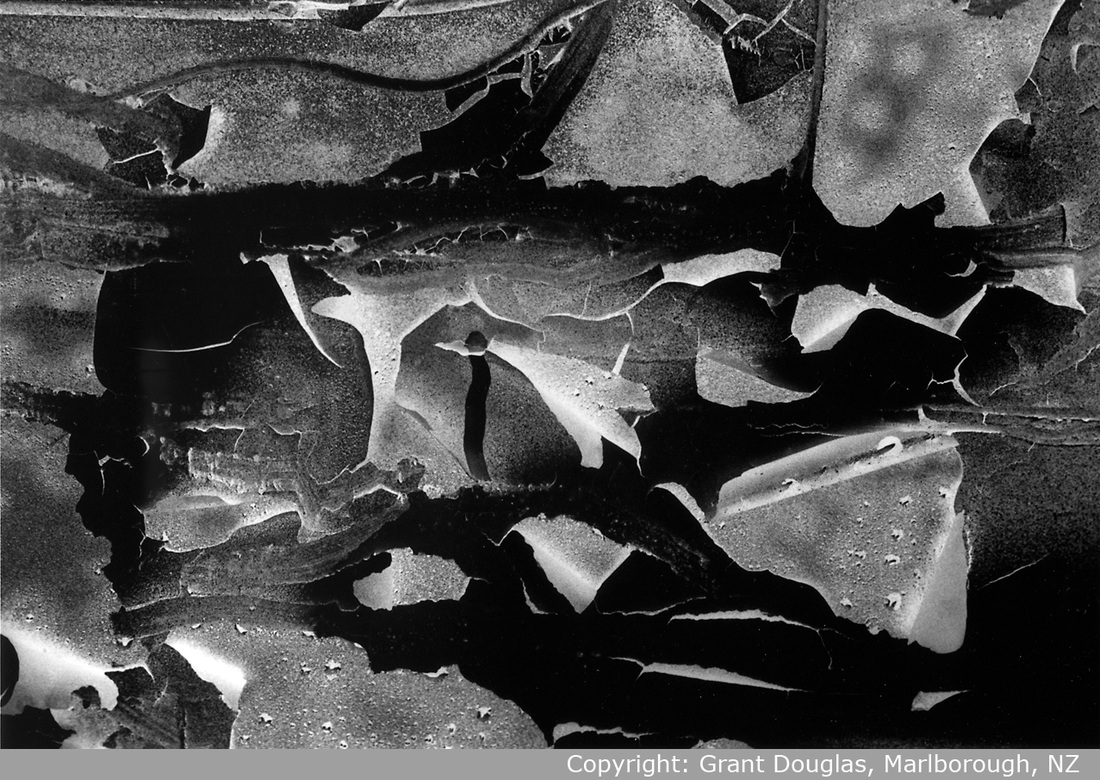|
The Friday Photo is a new blog series that I intend to add to weekly. There will be no deliberate method in the choice of photograph; rather, it will be a photo that just crops up somehow during the preceding week. I hope you enjoy the column, and please feel free share it among your friends (via links - the photograph is copyright). OK, it’s a photo of some old, peeling paintwork. Now that the subject of the photo has been identified, you can move on. But wait, there’s more. We’re more conditioned than at any time in the past to glance at photographs, identify what it is they depict and move speedily to the next. But the photographer, Grant Douglas, would rather you lingered. Once the subject of the photograph has been identified, that’s when you can really begin to look at it. In the case of this photo, it really doesn’t matter what it is a of. That is not the point. As soon as you get past what the photo is of, you can begin to enjoy it as an image. By focusing closely in on everyday objects, or parts of objects, I aim to produce mostly ambiguous abstraction which can be interpreted by the viewer in a unique way, depending on their own sensibilities, but which may also have an ‘equivalence’ that offers an insight into something other than the object photographed. - Grant Douglas, exhibition statement, 2013 The concept of equivalence comes from Alfred Stieglitz, as the result of a series of photographs of clouds that he took in the 1920-30s – see http://en.wikipedia.org/wiki/Equivalents Simply put, the photographs use one subject, usually concentrating on its abstract qualities, to talk about something else; and what that something else might be is left to the individual viewer. Grant Douglas is NZ-based, and is one photographer among many - Minor White, Edward Weston, Aaron Siskind, Harry Callahan, Paul Caponigro, et al - who have made a long term commitment to photographing the world’s details with the greatest care. All of his exhibition work since the late 1970s has been of this nature. Sometimes the things photographed are man-made, sometimes natural, but always there is a sense of wonder in their contemplation that culminates in their rendition as high quality photographic prints. This photograph of peeling paint, and all of the other photographs that Douglas has made (some in which the subjects are less identifiable and thereby more puzzling), invite you to slow down and really look at a thing and wonder over it, as he does. And it is worth it. Extra
The exhibition print of this image was hand-printed by Grant Douglas in 2012 in his darkroom, on 10” x 12” fibre-based paper, and then selenium toned. The relatively small size is traditional, and intimate. A large print would gain impact, perhaps, but at the probable cost of closer contemplation and personal communication with the viewer. Darkroom printing is these days pretty much the preserve of gallery-exhibiting "fine art" photographers, as most enthusiasts have now moved to digital printing, and the professional, commercial photographers abandoned the analogue medium long ago. Digital printing is also now established as the main way for exhibiting photographers to present their work, since the quality of papers, inks, software and hardware available more recently is superb, and a greater level of print control than that available to darkroom printers is possible. Concerns over the archival stability of high quality digital prints have been resolved and they now exceed most traditional photographic printing methods in this regard. (Note: the photographers who used to make good darkroom prints but have shifted to digital media are now amongst the best digital printmakers.) However, a well-made darkroom print is still a beautiful object and survives comparison to the highest level of digital printing. It’s a bit like a vinyl record; there is still a place for it, and many connoisseurs still prefer it. The arguments on either side are complex and legion, but somewhat pointless when there is room for both types of print in the world. It remains a personal choice for both photographer and collector, and there is really no need to come down on or side or the other: they are both good. I would certainly encourage collectors of silver prints to learn to appreciate digital prints.
0 Comments
Your comment will be posted after it is approved.
Leave a Reply. |
AuthorPhotography Matters II Categories |


 RSS Feed
RSS Feed
